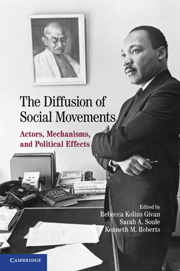Book contents
- Frontmatter
- Contents
- List of Tables
- List of Figures
- Contributors
- Preface and Acknowledgments
- 1 Introduction: The Dimensions of Diffusion
- PART I DIFFUSION AND THE FRAMING OF CONTENTIOUS POLITICS
- PART II MECHANISMS OF DIFFUSION
- 6 Dialogue Matters: Beyond the Transmission Model of Transnational Diffusion between Social Movements
- 7 The Diffusion of Different Types of Internet Activism: Suggestive Patterns in Website Adoption of Innovations
- 8 Transnational Networks, Diffusion Dynamics, and Electoral Change in the Postcommunist World
- 9 Diffusing the Rumor Bomb: “John Kerry Is French” (i.e., Haughty, Foppish, Elitist, Socialist, Cowardly, and Gay)
- PART III DIFFUSION, SCALE SHIFT, AND ORGANIZATIONAL CHANGE
- General Bibliography
- Index
7 - The Diffusion of Different Types of Internet Activism: Suggestive Patterns in Website Adoption of Innovations
Published online by Cambridge University Press: 05 June 2012
- Frontmatter
- Contents
- List of Tables
- List of Figures
- Contributors
- Preface and Acknowledgments
- 1 Introduction: The Dimensions of Diffusion
- PART I DIFFUSION AND THE FRAMING OF CONTENTIOUS POLITICS
- PART II MECHANISMS OF DIFFUSION
- 6 Dialogue Matters: Beyond the Transmission Model of Transnational Diffusion between Social Movements
- 7 The Diffusion of Different Types of Internet Activism: Suggestive Patterns in Website Adoption of Innovations
- 8 Transnational Networks, Diffusion Dynamics, and Electoral Change in the Postcommunist World
- 9 Diffusing the Rumor Bomb: “John Kerry Is French” (i.e., Haughty, Foppish, Elitist, Socialist, Cowardly, and Gay)
- PART III DIFFUSION, SCALE SHIFT, AND ORGANIZATIONAL CHANGE
- General Bibliography
- Index
Summary
There has been substantial interest in Internet activism among academics from a wide spectrum of fields over the past decade. Whether studying unlikely Internet phenoms such as the Zapatistas (e.g., Garrido and Halavais 2003), theorizing about the relationship between information technology and social movements (e.g., Tarrow 1998b; Tilly 2004), or examining how specific protest tactics, such as online petitions, have made their way online (Earl 2006a; Earl and Schussman 2007; Earl and Kimport 2008), researchers have been working to understand the impacts of a large array of new digital technologies.
One question that has been raised, but far from sufficiently answered, involves the dynamics of diffusion online. For instance, a number of scholars have argued that Internet usage can lead to changes in the scale of organizing (Foot and Schneider 2002) by increasing the speed of diffusion (Ayres 1999), increasing the size of the audience (Myers 1994), or increasing the global reach of messages (Garrido and Halavais 2003). Other authors have stressed the spread of online activism to new types of participants and to address novel issues (Earl and Kimport 2009). However, little is known thus far about the processes involved and how far different types of diffusion have already progressed (but see Earl 2010 for a theoretical review of potential broad types of diffusion relevant to online protest).
- Type
- Chapter
- Information
- The Diffusion of Social MovementsActors, Mechanisms, and Political Effects, pp. 125 - 139Publisher: Cambridge University PressPrint publication year: 2010
- 9
- Cited by

